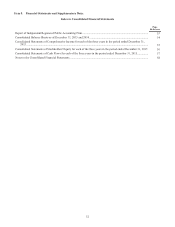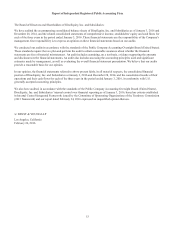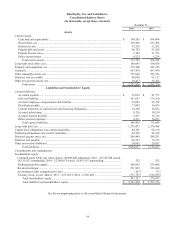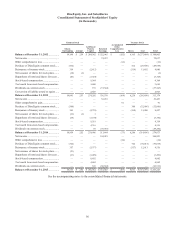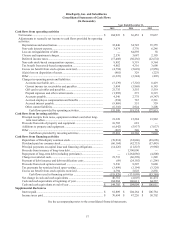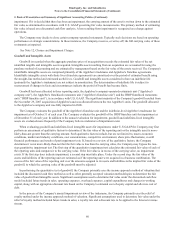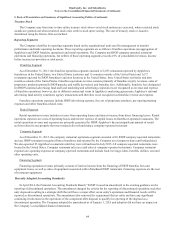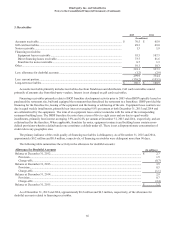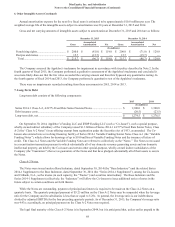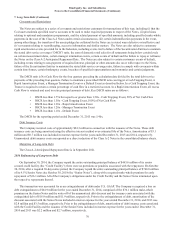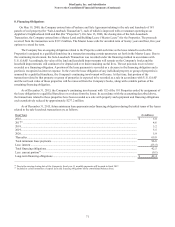IHOP 2015 Annual Report Download - page 82
Download and view the complete annual report
Please find page 82 of the 2015 IHOP annual report below. You can navigate through the pages in the report by either clicking on the pages listed below, or by using the keyword search tool below to find specific information within the annual report.DineEquity, Inc. and Subsidiaries
Notes to the Consolidated Financial Statements (Continued)
2. Basis of Presentation and Summary of Significant Accounting Policies (Continued)
62
when calculating depreciation of leasehold improvements, when determining straight-line rent expense and when determining
classification of its leases as either operating or capital. For leases that contain rent escalations, the Company records the total
rent payable during the lease term, as determined above, on the straight-line basis over the term of the lease (including the rent
holiday period beginning upon our possession of the premises), and records the difference between the minimum rents paid and
the straight-line rent as a lease obligation. Certain leases contain provisions that require additional rental payments based upon
restaurant sales volume (“contingent rent”). Contingent rentals are accrued each period as the liabilities are incurred, in addition
to the straight-line rent expense noted above.
Certain lease agreements contain tenant improvement allowances, rent holidays and lease premiums, which are amortized
over the shorter of the estimated useful life or lease term. For tenant improvement allowances, the Company also records a
deferred rent liability or an obligation in non-current liabilities on the consolidated balance sheets and amortizes the deferred
rent over the term of the lease as a reduction to company restaurant expenses in the consolidated statements of comprehensive
income.
Pre-opening Expenses
Expenditures related to the opening of new or relocated restaurants are charged to expense when incurred.
Advertising
Franchise fees designated for IHOP's national advertising fund and local marketing and advertising cooperatives are
recognized as revenue as the fees are earned and become receivables from the franchisee in accordance with U.S. GAAP
governing the accounting for franchise fee revenue. In accordance with U.S. GAAP governing advertising costs, related
advertising obligations are accrued and the costs expensed at the same time the related revenue is recognized. Due to different
contractual terms in Applebee's marketing agreements, franchise fees designated for Applebee's national advertising fund and
local advertising cooperatives constitute agency transactions and are not recognized as revenues and expenses. In both cases,
the advertising fees are recorded as a liability against which specific costs are charged. Advertising fees included in IHOP
franchise revenue and expense for the years ended December 31, 2015, 2014 and 2013 were $108.1 million, $90.3 million and
$79.5 million, respectively.
Advertising expense reflected in the consolidated statements of comprehensive income includes local marketing
advertising costs incurred by company-operated restaurants, contributions to the national advertising fund made by Applebee's
and IHOP company-operated restaurants and certain advertising costs incurred by the Company to benefit future franchise
operations. Costs of advertising are expensed either as incurred or the first time the advertising takes place. Advertising
expense included in company restaurant operations for the years ended December 31, 2015, 2014 and 2013 was $1.9 million,
$2.9 million and $2.9 million, respectively.
Fair Value Measurements
The Company determines the fair market values of its financial assets and liabilities, as well as non-financial assets and
liabilities that are recognized or disclosed at fair value on a recurring basis, based on the fair value hierarchy established in
U.S. GAAP. As necessary, the Company measures its financial assets and liabilities using inputs from the following three levels
of the fair value hierarchy:
• Level 1 inputs are quoted prices in active markets for identical assets or liabilities.
• Level 2 inputs are observable for the asset or liability, either directly or indirectly, including quoted prices in active
markets for similar assets or liabilities.
• Level 3 inputs are unobservable and reflect the Company's own assumptions.
The Company does not have a material amount of financial assets or liabilities that are required under U.S. GAAP to be
measured at fair value on either a recurring or non-recurring basis. None of the Company's non-financial assets or non-financial
liabilities is required to be measured at fair value on a recurring basis. The Company has not elected to use fair value
measurement for any assets or liabilities for which fair value measurement is not presently required.
The Company believes the fair values of cash equivalents, accounts receivable and accounts payable approximate their
carrying amounts due to their short duration.


